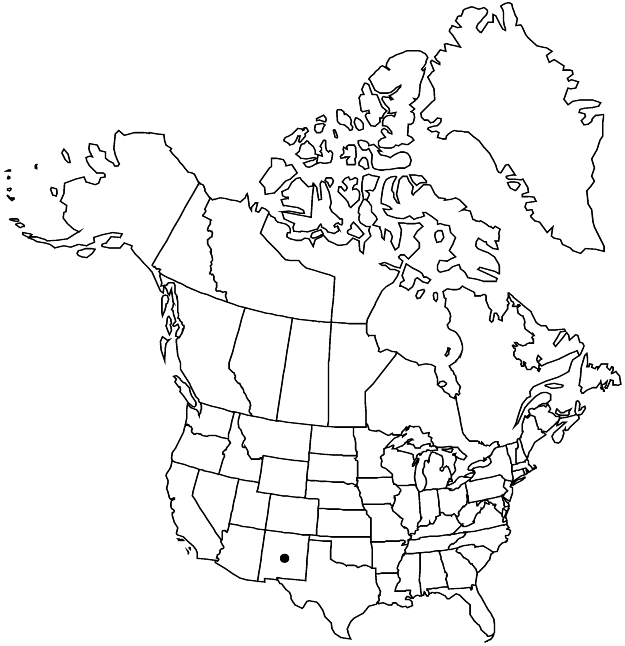Difference between revisions of "Eriogonum aliquantum"
Phytologia 34: 460. 1976.
FNA>Volume Importer |
imported>Volume Importer |
||
| (5 intermediate revisions by one other user not shown) | |||
| Line 8: | Line 8: | ||
}} | }} | ||
|common_names=Cimarron wild buckwheat | |common_names=Cimarron wild buckwheat | ||
| + | |special_status={{Treatment/ID/Special_status | ||
| + | |code=E | ||
| + | |label=Endemic | ||
| + | }} | ||
|basionyms= | |basionyms= | ||
|synonyms= | |synonyms= | ||
| Line 24: | Line 28: | ||
|elevation=1900-2100 m | |elevation=1900-2100 m | ||
|distribution=N.Mex. | |distribution=N.Mex. | ||
| − | |discussion=<p>Eriogonum aliquantum is known only from the Cimarron, Vermejo, and Canadian river basins in Colfax County. Morphologically it is similar to E. visheri from the northern Great Plains, and a clear distinction is not always possible. Although considered a candidate for federal protection since the late 1970s, E. aliquantum remains essentially forgotten.</p> | + | |discussion=<p><i>Eriogonum aliquantum</i> is known only from the Cimarron, Vermejo, and Canadian river basins in Colfax County. Morphologically it is similar to <i>E. visheri</i> from the northern Great Plains, and a clear distinction is not always possible. Although considered a candidate for federal protection since the late 1970s, <i>E. aliquantum</i> remains essentially forgotten.</p> |
|tables= | |tables= | ||
|references= | |references= | ||
| Line 33: | Line 37: | ||
-->{{#Taxon: | -->{{#Taxon: | ||
name=Eriogonum aliquantum | name=Eriogonum aliquantum | ||
| − | |||
|authority=Reveal | |authority=Reveal | ||
|rank=species | |rank=species | ||
| Line 47: | Line 50: | ||
|publication title=Phytologia | |publication title=Phytologia | ||
|publication year=1976 | |publication year=1976 | ||
| − | |special status= | + | |special status=Endemic |
| − | |source xml=https:// | + | |source xml=https://bitbucket.org/aafc-mbb/fna-data-curation/src/2e0870ddd59836b60bcf96646a41e87ea5a5943a/coarse_grained_fna_xml/V5/V5_800.xml |
|subfamily=Polygonaceae subfam. Eriogonoideae | |subfamily=Polygonaceae subfam. Eriogonoideae | ||
|genus=Eriogonum | |genus=Eriogonum | ||
Latest revision as of 22:14, 5 November 2020
Herbs, erect to spreading, annual, 1.5–3.5 dm, sparsely villous, grayish. Stems: caudex absent; aerial flowering stems erect, solid, not fistulose, 0.3–0.7 dm, sparsely villous. Leaves basal and cauline; basal: petiole 1.5–2.5 cm, sparsely villous, blade elliptic to broadly elliptic, 1.5–2 × 1–1.5 cm, glabrous and green on both surfaces, margins entire, villous; cauline: petiole 0.5–1 cm, sparsely villous, blade elliptic, 0.5–1.5 × 0.2–1 cm, similar to basal blade. Inflorescences cymose, open, 15–25 × 15–25 cm; branches not fistulose, sparsely villous; bracts 3, scalelike, 1–4 × 1–3 mm. Peduncles absent or rarely 1 at proximal node, erect, straight, slender, 0.3–0.7 cm, villous. Involucres turbinate-campanulate, 1–1.3 × 1–1.2 mm; teeth 5, erect, 0.4–0.6 mm. Flowers 1.2–2 mm, glabrous; perianth yellowish with darker yellowish brown to reddish brown midribs, glabrous; tepals monomorphic, oblanceolate; stamens exserted, 1.3–1.5 mm; filaments glabrous. Achenes shiny light brown to brown, 3-gonous, 1.7–2.3 mm, glabrous.
Phenology: Flowering Jun–Aug.
Habitat: Clayey flats, saltbush and sagebrush communities, montane conifer woodlands
Elevation: 1900-2100 m
Discussion
Eriogonum aliquantum is known only from the Cimarron, Vermejo, and Canadian river basins in Colfax County. Morphologically it is similar to E. visheri from the northern Great Plains, and a clear distinction is not always possible. Although considered a candidate for federal protection since the late 1970s, E. aliquantum remains essentially forgotten.
Selected References
None.
